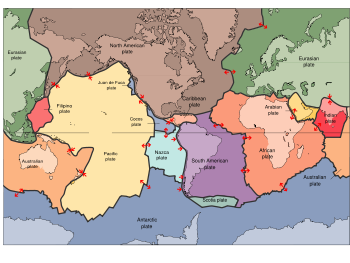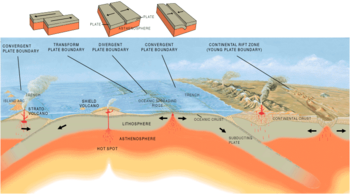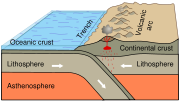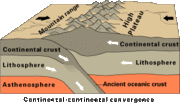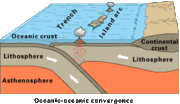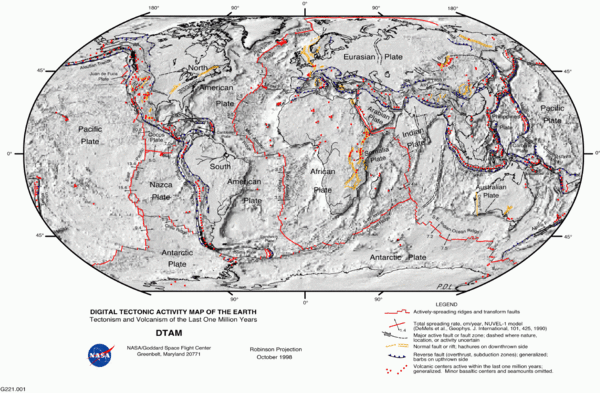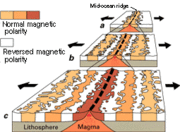Plate tectonics
2007 Schools Wikipedia Selection. Related subjects: Geology and geophysics
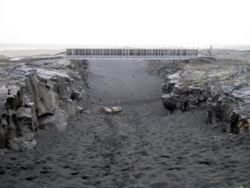
Plate tectonics (from Greek τέκτων, tektōn "builder" or "mason") is a theory of geology which was developed to explain the observed evidence for large scale motions within the Earth's crust. The theory encompassed and superseded the older theory of continental drift from the first half of the 20th century and the concept of sea floor spreading developed during the 1960s.
The outermost part of the Earth's interior is made up of two layers: above is the lithosphere, comprising the crust and the rigid uppermost part of the mantle. Below the lithosphere lies the asthenosphere, which is a more viscous zone of the mantle. Although solid, the asthenosphere has very low shear strength and can flow like a liquid on geological time scales. The deeper mantle below the asthenosphere is more rigid again.
The lithosphere essentially floats on the asthenosphere. The lithosphere has broken up into what are called tectonic plates—in the case of Earth, there are ten major and many minor plates. These plates move in relation to one another at one of three types of plate boundaries: convergent, divergent, and transform. Earthquakes, volcanic activity, mountain-building, and oceanic trench formation occur along plate boundaries. The lateral movement of the plates is typically at speeds of several centimetres per year.
Synopsis on development
Plate tectonic theory is currently the theory accepted by the vast majority of scientists working in the geosciences. It arose out of and was preceded by early hypotheses associated with continental drift, and following the development of the mechanism of seafloor spreading, (for which the detection of magnetic anomalies distributed by a clear pattern of parallel stripes on the seafloor served as impressive evidence) plate tectonics quickly became a theory on the brink of scientific revolution. Simultaneous advances in early seismic imaging techniques in and around wadati-benioff zones collectively with numerous other geologic observations soon solidified plate tectonics as a theory with extraordinary explanatory and predictive power in subsequent decades (and continuing). Plate tectonics was developed during the late 1960s and has since been essentially universally accepted by scientists as predominant throughout all geoscientific disciplines. The theory has revolutionized the earth sciences because of its unifying and explanatory power for diverse geological phenomena.
Key principles
The division of the outer parts of the Earth's interior into lithospheric and asthenospheric components is based on their mechanical differences. The lithosphere is cooler and more rigid, whilst the asthenosphere is hotter and mechanically weaker. This division should not be confused with the chemical subdivision of the Earth into (from innermost to outermost) core, mantle, and crust. The lithosphere contains both crust and some mantle. A given piece of mantle may be part of the lithosphere or the asthenosphere at different times, depending on its temperature, pressure and shear strength. The key principle of plate tectonics is that the lithosphere exists as separate and distinct tectonic plates, which float on the fluid-like (visco-elastic solid) asthenosphere. The relative fluidity of the asthenosphere allows the tectonic plates to undergo motion in different directions.
The plates are around 100 km (60 miles) thick and consist of lithospheric mantle overlain by either of two types of crustal material: oceanic crust (in older texts called sima from silicon and magnesium) and continental crust ( sial from silicon and aluminium). The two types of crust differ in thickness, with continental crust considerably thicker than oceanic (50 km vs 5 km).
One plate meets another along a plate boundary, and plate boundaries are commonly associated with geological events such as earthquakes and the creation of topographic features like mountains, volcanoes and oceanic trenches. The majority of the world's active volcanoes occur along plate boundaries, with the Pacific Plate's Ring of Fire being most active and famous. These boundaries are discussed in further detail below.
Tectonic plates can include continental crust or oceanic crust, and typically, a single plate carries both. For example, the African Plate includes the continent and parts of the floor of the Atlantic and Indian Oceans. The distinction between continental crust and oceanic crust is based on the density of constituent materials; oceanic crust is denser than continental crust owing to their different proportions of various elements, particularly, silicon. Oceanic crust has less silicon and more heavier elements (" mafic") than continental crust (" felsic").
As a result, oceanic crust generally lies below sea level (for example most of the Pacific Plate), while the continental crust projects above sea level (see isostasy for explanation of this principle).
Types of plate boundaries
Three types of plate boundaries exist, characterized by the way the plates move relative to each other. They are associated with different types of surface phenomena. The different types of plate boundaries are:
- Transform boundaries occur where plates slide or, perhaps more accurately, grind past each other along transform faults. The relative motion of the two plates is either sinistral (left side toward the observer) or dextral (right side toward the observer).
- Divergent boundaries occur where two plates slide apart from each other (examples of which can be seen at mid-ocean ridges and active zones of rifting (such as with the East Africa rift)).
- Convergent boundaries (or active margins) occur where two plates slide towards each other commonly forming either a subduction zone (if one plate moves underneath the other) or a continental collision (if the two plates contain continental crust). Deep marine trenches are typically associated with subduction zones. Because of friction and heating of the subducting slab, volcanism is almost always closely linked. Examples of this are the Andes mountain range in South America and the Japanese island arc.
Transform (conservative) boundaries
The left- or right-lateral motion of one plate against another along transform faults can cause highly visible surface effects. Because of friction, the plates cannot simply glide past each other. Rather, stress builds up in both plates and when it reaches a level that exceeds the strain threshold of rocks on either side of the fault the accumulated potential energy is released as strain. Strain is both accumulative and instantaneous depending on the rheology of the rock; the ductile lower crust and mantle accumulates deformation gradually via shearing whereas the brittle upper crust reacts by fracture, or instantaneous stress release to cause motion along the fault. The ductile surface of the fault can also release instantaneously when the strain rate is too great. The energy released by instantaneous strain release is the cause of earthquakes, a common phenomenon along transform boundaries.
A good example of this type of plate boundary is the San Andreas Fault which is found in the western coast of North America and is one part of a highly complex system of faults in this area. At this location, the Pacific and North American plates move relative to each other such that the Pacific plate is moving northwest with respect to North America. Other examples of transform faults include the Alpine Fault in New Zealand and the North Anatolian Fault in Turkey. Transform faults are also found offsetting the crests of mid-ocean ridges (for example, the Mendocino Fracture Zone offshore northern California).
Divergent (constructive) boundaries
At divergent boundaries, two plates move apart from each other and the space that this creates is filled with new crustal material sourced from molten magma that forms below. The origin of new divergent boundaries at triple junctions is sometimes thought to be associated with the phenomenon known as hotspots. Here, exceedingly large convective cells bring very large quantities of hot asthenospheric material near the surface and the kinetic energy is thought to be sufficient to break apart the lithosphere. The hot spot which may have initiated the Mid-Atlantic Ridge system currently underlies Iceland which is widening at a rate of a few centimeters per century.
Divergent boundaries are typified in the oceanic lithosphere by the rifts of the oceanic ridge system, including the Mid-Atlantic Ridge and the East Pacific Rise, and in the continental lithosphere by rift valleys such as the famous East African Great Rift Valley. Divergent boundaries can create massive fault zones in the oceanic ridge system. Spreading is generally not uniform, so where spreading rates of adjacent ridge blocks are different massive transform faults occur. These are the fracture zones, many bearing names, that are a major source of submarine earthquakes. A sea floor map will show a rather strange pattern of blocky structures that are separated by linear features perpendicular to the ridge axis. If one views the sea floor between the fracture zones as conveyor belts carrying the ridge on each side of the rift away from the spreading center the action becomes clear. Crest depths of the old ridges, parallel to the current spreading centre, will be older and deeper (from thermal contraction and subsidence).
It is at mid-ocean ridges that one of the key pieces of evidence forcing acceptance of the sea-floor spreading hypothesis was found. Airborne geomagnetic surveys showed a strange pattern of symmetrical magnetic reversals on opposite sides of ridge centers. The pattern was far too regular to be coincidental as the widths of the opposing bands were too closely matched. Scientists had been studying polar reversals and the link was made. The magnetic banding directly corresponds with the Earth's polar reversals. This was confirmed by measuring the ages of the rocks within each band. The banding furnishes a map in time and space of both spreading rate and polar reversals.
Convergent (destructive) boundaries
The nature of a convergent boundary depends on the type of lithosphere in the plates that are colliding. Where a dense oceanic plate collides with a less-dense continental plate, the oceanic plate is typically thrust underneath because of the greater buoyancy of the continental lithosphere, forming a subduction zone. At the surface, the topographic expression is commonly an oceanic trench on the ocean side and a mountain range on the continental side. An example of a continental-oceanic subduction zone is the area along the western coast of South America where the oceanic Nazca Plate is being subducted beneath the continental South American Plate.
While the processes directly associated with the production of melts directly above downgoing plates producing surface volcanism is the subject of some debate in the geologic community, the general consensus from ongoing research suggests that the release of volatiles is the primary contributor. As the subducting plate descends, its temperature rises driving off volatiles (most importantly water) encased in the porous oceanic crust. As this water rises into the mantle of the overriding plate, it lowers the melting temperature of surrounding mantle, producing melts (magma) with large amounts of dissolved gases. These melts rise to the surface and are the source of some of the most explosive volcanism on earth because of their high volumes of extremely pressurized gases (consider Mount St. Helens). The melts rise to the surface and cool forming long chains of volcanoes inland from the continental shelf and parallel to it. The continental spine of western South America is dense with this type of volcanic mountain building from the subduction of the Nazca plate. In North America the Cascade mountain range, extending north from California's Sierra Nevada, is also of this type. Such volcanoes are characterized by alternating periods of quiet and episodic eruptions that start with explosive gas expulsion with fine particles of glassy volcanic ash and spongy cinders, followed by a rebuilding phase with hot magma. The entire Pacific Ocean boundary is surrounded by long stretches of volcanoes and is known collectively as The Ring of Fire.
Where two continental plates collide the plates either buckle and compress or one plate delves under or (in some cases) overrides the other. Either action will create extensive mountain ranges. The most dramatic effect seen is where the northern margin of the Indian Plate is being thrust under a portion of the Eurasian plate, lifting it and creating the Himalayas and the Tibetan Plateau beyond. It has also caused parts of the Asian continent to deform westward and eastward on either side of the collision.
When two plates with oceanic crust converge they typically create an island arc as one plate is subducted below the other. The arc is formed from volcanoes which erupt through the overriding plate as the descending plate melts below it. The arc shape occurs because of the spherical surface of the earth (nick the peel of an orange with a knife and note the arc formed by the straight-edge of the knife). A deep undersea trench is located in front of such arcs where the descending slab dips downward. Good examples of this type of plate convergence would be Japan and the Aleutian Islands in Alaska.
Plates may collide at an oblique angle rather than head-on (e.g. one plate moving north, the other moving south-east), and this may cause strike-slip faulting along the collision zone, in addition to subduction.
Not all plate boundaries are easily defined. Some are broad belts whose movements are unclear to scientists. One example would be the Mediterranean-Alpine boundary, which involves two major plates and several micro plates. The boundaries of the plates do not necessarily coincide with those of the continents. For instance, the North American Plate covers not only North America, but also far eastern Siberia and northern Japan.
Driving forces of plate motion
Plates are able to move because of the relative weakness of the asthenosphere. Dissipation of heat from the mantle is acknowledged to be the original source of energy driving plate tectonics.
Two and three-dimensional imaging of the Earth's interior ( seismic tomography) shows that there is a laterally heterogeneous density distribution throughout the mantle. Such density variations can be material (from rock chemistry), mineral (from variations in mineral structures), or thermal (through thermal expansion and contraction from heat energy). The manifestation of this lateral density heterogeneity is [[mantle convection] from buoyancy forces. Tanimoto 2000. How mantle convection relates directly and indirectly to the motion of the plates is a matter of ongoing study and discussion in geodynamics. Somehow, this energy must be transferred to the lithosphere in order for tectonic plates to move. There are essentially two types of forces that are thought to influence plate motion: friction and gravity.
Friction
- Basal drag
- Large scale convection currents in the upper mantle are transmitted through the asthenosphere; motion is driven by friction between the asthenosphere and the lithosphere.
- Slab suction
- Local convection currents exert a downward frictional pull on plates in subduction zones at ocean trenches. Although, one could in effect argue that Slab-suction is actually merely a unique geodynamic setting wherein which basal tractions continue to act on the plate as it dives into the mantle (although perhaps to a greater extent -- acting on both the under and upper side of the slab).
Gravitation
- Gravitational sliding
- Plate motion is driven by the higher elevation of plates at ocean ridges. As oceanic lithosphere is formed at spreading ridges from hot mantle material it gradually cools and thickens with age (and thus distance from the ridge). Cool oceanic lithosphere is significantly denser than the hot mantle material from which it is derived and so with increasing thickness it gradually subsides into the mantle to compensate the greater load. The result is a slight lateral incline with distance from the ridge axis.
Casually in the geophysical community and more typically in the geological literature in lower education this process is often referred to as "ridge-push". This is, in fact, a misnomer as nothing is "pushing" and tensional features are dominant along ridges. It is more accurate to refer to this mechanism as gravitational sliding as variable topography across the totality of the plate can vary considerably and the topography of spreading ridges is only the most prominent feature. For example:
- 1. Flexural bulging of the lithosphere before it dives underneath an adjacent plate, for instance, produces a clear topographical feature that can offset or at least effect the influence of topographical ocean ridges.
- 2. Mantle plumes impinging on the underside of tectonic plates can drastically alter the topography of the ocean floor.
- Slab-pull
- Plate motion is driven by the weight of cold, dense plates sinking into the mantle at trenches. There is considerable evidence that convection is occurring in the mantle at some scale. The upwelling of material at mid-ocean ridges is almost certainly part of this convection. Some early models of plate tectonics envisioned the plates riding on top of convection cells like conveyor belts. However, most scientists working today believe that the asthenosphere is not strong enough to directly cause motion by the friction of such basal forces. Slab pull is most widely thought to be the greatest force acting on the plates. Recent models indicate that trench suction plays an important role as well. However, it should be noted that the North American Plate, for instance, is nowhere being subducted, yet it is in motion. Likewise the African, Eurasian and Antarctic Plates. The over-all driving force for plate motion and its energy source remain subjects of on-going research.
External forces
In a study published in the January-February 2006 issue of the Geological Society of America Bulletin, a team of Italian and U.S. scientists argued that the westward component of plates is from Earth's rotation and consequent tidal friction of the moon. As the Earth spins eastward beneath the moon, they say, the moon's gravity ever so slightly pulls the Earth's surface layer back westward. It has also been suggested (albeit, controversially) that this observation may also explain why Venus and Mars have no plate tectonics since Venus has no moon, and Mars' moons are too small to have significant tidal effects on Mars. This is not, however, a new argument.
It was originally raised by the "father" of the plate tectonics hypothesis, Alfred Wegener. It was challenged by the physicist Harold Jeffreys who calculated that the magnitude of tidal friction required would have quickly brought the Earth's rotation to a halt long ago. Many plates are moving north and eastward, and the dominantly westward motion of the Pacific ocean basins is simply from the eastward bias of the Pacific spreading centre (which is not a predicted manifestation of such lunar forces). It is argued, however, that relative to the lower mantle, there is a slight westward component in the motions of all the plates.
Relative significance of each mechanism
The actual vector of a plate's motion must necessarily be a function of all the forces acting upon the plate. However, therein remains the problem of to what degree each process contributes to the motion of each tectonic plate.
The diversity of geodynamic settings and properties of each plate must clearly result in differences in the degree to which such processes are actively driving the plates. One method of dealing with this problem is to consider the relative rate at which each plate is moving and to consider the available evidence of each driving force upon the plate as far as possible.
One of the most significant correlations found is that lithospheric plates attached to downgoing (subducting) plates move much faster than plates not attached to subducting plates. The pacific plate, for instance, is essentially surrounded by zones of subduction (the so-called Ring of Fire) and moves much faster than the plates of the Atlantic basin, which are attached (perhaps one could say 'welded') to adjacent continents instead of subducting plates. It is thus thought that forces associated with the downgoing plate (slab pull and slab suction) are the driving forces which determine the motion of plates.
The driving forces of plate motion are, nevertheless, still very active subjects of on-going discussion and research in the geophysical community.
Major plates
The main plates are
- African Plate, covering Africa - Continental plate
- Antarctic Plate, covering Antarctica - Continental plate
- Australian Plate, covering Australia (fused with Indian Plate between 50 and 55 million years ago) - Continental plate
- Eurasian Plate covering Asia and Europe - Continental plate
- North American Plate covering North America and north-east Siberia - Continental plate
- South American Plate covering South America - Continental plate
- Pacific Plate, covering the Pacific Ocean - Oceanic plate
Notable minor plates include the Indian Plate, the Arabian Plate, the Caribbean Plate, the Juan de Fuca Plate, the Nazca Plate, the Philippine Plate and the Scotia Plate.
The movement of plates has caused the formation and break-up of continents over time, including occasional formation of a supercontinent that contains most or all of the continents. The supercontinent Rodinia is thought to have formed about 1000 million years ago and to have embodied most or all of Earth's continents, and broken up into eight continents around 600 million years ago. The eight continents later re-assembled into another supercontinent called Pangaea; Pangea eventually broke up into Laurasia (which became North America and Eurasia) and Gondwana (which became the remaining continents).
- Related article
- List of tectonic plates
Continental drift
Continental drift was one of many ideas about tectonics proposed in the late 19th and early 20th centuries. The theory has been superseded by and the concepts and data have been incorporated within plate tectonics.
By 1915, Alfred Wegener was making serious arguments for the idea of the first edition of The Origin of Continents and Oceans. In that book, he noted how the east coast of South America and the west coast of Africa looked as if they were once attached. Wegener wasn't the first to note this (Francis Bacon, Benjamin Franklin and Snider-Pellegrini preceded him), but he was the first to marshal significant fossil and paleo-topographical and climatological evidence to support this simple observation (and was supported in this by researchers such as Alex du Toit). However, his ideas were not taken seriously by many geologists, who pointed out that there was no apparent mechanism for continental drift. Specifically they did not see how continental rock could plow through the much denser rock that makes up oceanic crust. Wegener could not explain the force of continental drift.
Wegener's vindication did not come until after his death in 1930. In 1947, a team of scientists led by Maurice Ewing utilizing the Woods Hole Oceanographic Institution’s research vessel Atlantis and an array of instruments, confirmed the existence of a rise in the central Atlantic Ocean, and found that the floor of the seabed beneath the layer of sediments consisted of basalt, not granite which was common on the continents. They also found that the oceanic crust was much thinner than continental crust. All these new findings raised important and intriguing questions.
Beginning in the 1950s, scientists including Harry Hess, using magnetic instruments ( magnetometers) adapted from airborne devices developed during World War II to detect submarines, began recognizing odd magnetic variations across the ocean floor. This finding, though unexpected, was not entirely surprising because it was known that basalt -- the iron-rich, volcanic rock making up the ocean floor-- contains a strongly magnetic mineral ( magnetite) and can locally distort compass readings. This distortion was recognized by Icelandic mariners as early as the late 18th century. More important, because the presence of magnetite gives the basalt measurable magnetic properties, these newly discovered magnetic variations provided another means to study the deep ocean floor. When newly formed rock cools, such magnetic materials recorded the Earth's magnetic field at the time.
As more and more of the seafloor was mapped during the 1950s, the magnetic variations turned out not to be random or isolated occurrences, but instead revealed recognizable patterns. When these magnetic patterns were mapped over a wide region, the ocean floor showed a zebra-like pattern. Alternating stripes of magnetically different rock were laid out in rows on either side of the mid-ocean ridge: one stripe with normal polarity and the adjoining stripe with reversed polarity. The overall pattern, defined by these alternating bands of normally and reversely polarized rock, became known as magnetic striping.
When the rock strata of the tips of separate continents are very similar it suggests that these rocks were formed in the same way implying that they were joined initially. For instance, some parts of Scotland and Ireland contain rocks very similar to those found in Newfoundland and New Brunswick. Furthermore, the Caledonian Mountains of Europe and parts of the Appalachian Mountains of North America are very similar in structure and lithology.
Floating continents
The prevailing concept was that there were static shells of strata under the continents. It was early observed that although granite existed on continents, seafloor seemed to be composed of denser basalt. It was apparent that a layer of basalt underlies continental rocks.
However, based upon abnormalities in plumb line deflection by the Andes in Peru, Pierre Bouguer deduced that less-dense mountains must have a downward projection into the denser layer underneath. The concept that mountains had "roots" was confirmed by George B. Airy a hundred years later during study of Himalayan gravitation, and seismic studies detected corresponding density variations.
By the mid-1950s the question remained unresolved of whether mountain roots were clenched in surrounding basalt or were floating like an iceberg.
Plate tectonic theory
Significant progress was made in the 1960s, and was prompted by a number of discoveries, most notably the Mid-Atlantic ridge. The most notable was the 1962 publication of a paper by American geologist Harry Hess ( Robert S. Dietz published the same idea one year earlier in Nature. However, priority belongs to Hess, since he distributed an unpublished manuscript of his 1962 article already in 1960). Hess suggested that instead of continents moving through oceanic crust (as was suggested by continental drift) that an ocean basin and its adjoining continent moved together on the same crustal unit, or plate. In the same year, Robert R. Coats of the U.S. Geological Survey described the main features of island arc subduction in the Aleutian Islands. His paper, though little-noted (and even ridiculed) at the time, has since been called "seminal" and "prescient". In 1967, W. Jason Morgan proposed that the Earth's surface consists of 12 rigid plates that move relative to each other. Two months later, in 1968, Xavier Le Pichon published a complete model based on 6 major plates with their relative motions.
Explanation of magnetic striping
The discovery of magnetic striping and the stripes being symmetrical around the crests of the mid-ocean ridges suggested a relationship. In 1961, scientists began to theorise that mid-ocean ridges mark structurally weak zones where the ocean floor was being ripped in two lengthwise along the ridge crest. New magma from deep within the Earth rises easily through these weak zones and eventually erupts along the crest of the ridges to create new oceanic crust. This process, later called seafloor spreading, operating over many millions of years continues to form new ocean floor all across the 50,000 km-long system of mid-ocean ridges. This hypothesis was supported by several lines of evidence:
- at or near the crest of the ridge, the rocks are very young, and they become progressively older away from the ridge crest;
- the youngest rocks at the ridge crest always have present-day (normal) polarity;
- stripes of rock parallel to the ridge crest alternated in magnetic polarity (normal-reversed-normal, etc.), suggesting that the Earth's magnetic field has flip-flopped many times.
By explaining both the zebralike magnetic striping and the construction of the mid-ocean ridge system, the seafloor spreading hypothesis quickly gained converts and represented another major advance in the development of the plate-tectonics theory. Furthermore, the oceanic crust now came to be appreciated as a natural "tape recording" of the history of the reversals in the Earth's magnetic field.
Subduction discovered
A profound consequence of seafloor spreading is that new crust was, and is now, being continually created along the oceanic ridges. This idea found great favour with some scientists who claimed that the shifting of the continents can be simply explained by a large increase in size of the Earth since its formation. However, this so-called " Expanded earth theory" hypothesis was unsatisfactory because its supporters could offer no convincing geologic mechanism to produce such a huge, sudden expansion. Most geologists believe that the Earth has changed little, if at all, in size since its formation 4.6 billion years ago, raising a key question: how can new crust be continuously added along the oceanic ridges without increasing the size of the Earth?
This question particularly intrigued Harry Hess, a Princeton University geologist and a Naval Reserve Rear Admiral, and Robert S. Dietz, a scientist with the U.S. Coast and Geodetic Survey who first coined the term seafloor spreading. Dietz and Hess were among the small handful who really understood the broad implications of sea floor spreading. If the Earth's crust was expanding along the oceanic ridges, Hess reasoned, it must be shrinking elsewhere. He suggested that new oceanic crust continuously spread away from the ridges in a conveyor belt-like motion. Many millions of years later, the oceanic crust eventually descends into the oceanic trenches -- very deep, narrow canyons along the rim of the Pacific Ocean basin. According to Hess, the Atlantic Ocean was expanding while the Pacific Ocean was shrinking. As old oceanic crust was consumed in the trenches, new magma rose and erupted along the spreading ridges to form new crust. In effect, the ocean basins were perpetually being "recycled," with the creation of new crust and the destruction of old oceanic lithosphere occurring simultaneously. Thus, Hess' ideas neatly explained why the Earth does not get bigger with sea floor spreading, why there is so little sediment accumulation on the ocean floor, and why oceanic rocks are much younger than continental rocks.
Mapping with earthquakes
During the 20th century, improvements in and greater use of seismic instruments such as seismographs enabled scientists to learn that earthquakes tend to be concentrated in certain areas, most notably along the oceanic trenches and spreading ridges. By the late 1920s, seismologists were beginning to identify several prominent earthquake zones parallel to the trenches that typically were inclined 40-60° from the horizontal and extended several hundred kilometers into the Earth. These zones later became known as Wadati-Benioff zones, or simply Benioff zones, in honour of the seismologists who first recognized them, Kiyoo Wadati of Japan and Hugo Benioff of the United States. The study of global seismicity greatly advanced in the 1960s with the establishment of the Worldwide Standardized Seismograph Network (WWSSN) to monitor the compliance of the 1963 treaty banning above-ground testing of nuclear weapons. The much-improved data from the WWSSN instruments allowed seismologists to map precisely the zones of earthquake concentration world wide.
Geological paradigm shift
The acceptance of the theories of continental drift and sea floor spreading (the two key elements of plate tectonics) may be compared to the Copernican revolution in astronomy (see Nicolaus Copernicus). Within a matter of only several years geophysics and geology in particular were revolutionized. The parallel is striking: just as pre-Copernican astronomy was highly descriptive but still unable to provide explanations for the motions of celestial objects, pre-tectonic plate geological theories described what was observed but struggled to provide any fundamental mechanisms. The problem lay in the question "How?". Before acceptance of plate tectonics, geology in particular was trapped in a "pre-Copernican" box.
However, by comparison to astronomy the geological revolution was much more sudden. What had been rejected for decades by any respectable scientific journal was eagerly accepted within a few short years in the 1960s and 1970s. Any geological description before this had been highly descriptive. All the rocks were described and assorted reasons, sometimes in excruciating detail, were given for why they were where they are. The descriptions are still valid. The reasons, however, today sound much like pre-Copernican astronomy.
One simply has to read the pre-plate descriptions of why the Alps or Himalaya exist to see the difference. In an attempt to answer "how" questions like "How can rocks that are clearly marine in origin exist thousands of meters above sea-level in the Dolomites?", or "How did the convex and concave margins of the Alpine chain form?", any true insight was hidden by complexity that boiled down to technical jargon without much fundamental insight as to the underlying mechanics.
With plate tectonics answers quickly fell into place or a path to the answer became clear. Collisions of converging plates had the force to lift the sea floor to great heights. The cause of marine trenches oddly placed just off island arcs or continents and their associated volcanoes became clear when the processes of subduction at converging plates were understood.
Mysteries were no longer mysteries. Forests of complex and obtuse answers were swept away. Why were there striking parallels in the geology of parts of Africa and South America? Why did Africa and South America look strangely like two pieces that should fit to anyone having done a jigsaw puzzle? Look at some pre-tectonics explanations for complexity. For simplicity and one that explained a great deal more look at plate tectonics. A great rift, similar to the Great Rift Valley in northeastern Africa, had split apart a single continent, eventually forming the Atlantic Ocean, and the forces were still at work in the Mid-Atlantic Ridge.
We have inherited some of the old terminology, but the underlying concept is as radical and simple as "The Earth moves" was in astronomy.
Biogeographic implications on fauna and flora
Contentinental drift theory helps biogeographers to explain on the disjunct biogeographic distribution of present day plants and animals found on different continents but having similar ancestors (Moss and Wilson 1998).
Plate tectonics on other planets
- Mars
As a result of 1999 observations of the magnetic fields on Mars by the Mars Global Surveyor spacecraft, it has been proposed that the mechanisms of plate tectonics may once have been active on the planet - see Geology of Mars.
- Venus
Venus shows no evidence of active plate tectonics. There is debatable evidence of active tectonics in the planet's distant past; however, events taking place since then (such as the plausible and generally accepted hypothesis that the Venusian lithosphere has thickened greatly over the course of several hundred million years) has made constraining the course of its geologic record difficult. However, the numerous well-preserved impact craters has been utilized as a dating method to approximately date the Venusian surface (as there are as of yet any known samples of Venusian rock to be dated by more reliable methods). Dates derived are the dominantly in the range ~500 Mya - 750Mya, although ages of up to ~1.2 Gya have been calculated. This research has led to the fairly well accepted hypothesis that Venus has undergone an essentially complete volcanic resurfacing at least once in its distant past, with the last event taking place approximately within the range of estimated surface ages. While the mechanism of such an impressionable thermal event remains a debated issue in Venusian geosciences, some scientists are advocates of processes involving plate motion to some extent.
- Galilean satellites
Some of the satellites of Jupiter have features that may be related to plate-tectonic style deformation, although the materials and specific mechanisms may be different from plate-tectonic activity on Earth.
Metaphoric uses
Sometimes the idea of moving tectonic plates is used metaphorically, e.g. "a tectonic shift" in a BBC TV news program describing the political effects of Ariel Sharon's illness on 4 January 2005.
In the late 1980s, Québec theatre director Robert Lepage created a large international production called Tectonic Plates, which used this image to illustrate the rifts between Europe and America and the drifting of various destinies, relative to one another.
